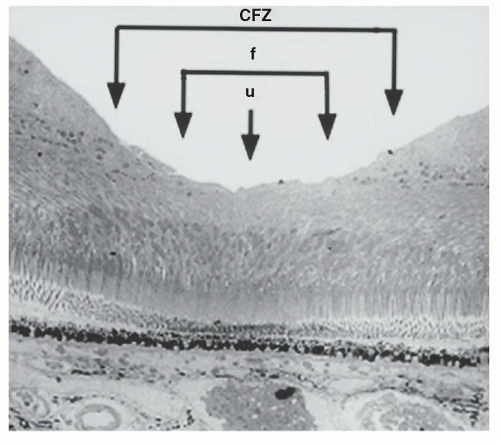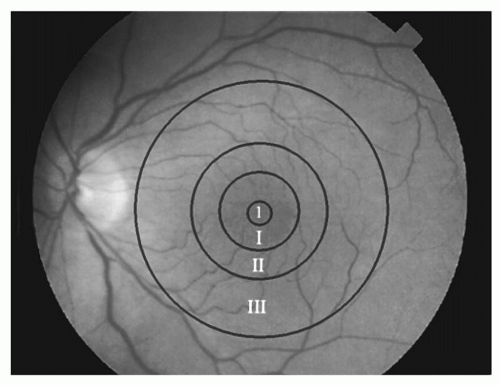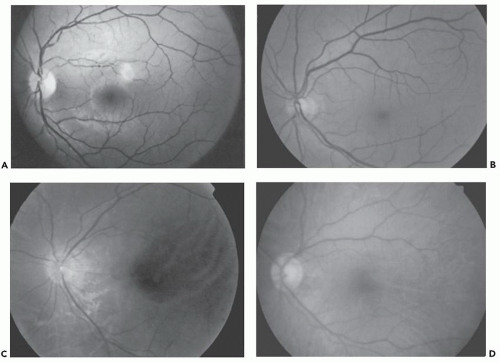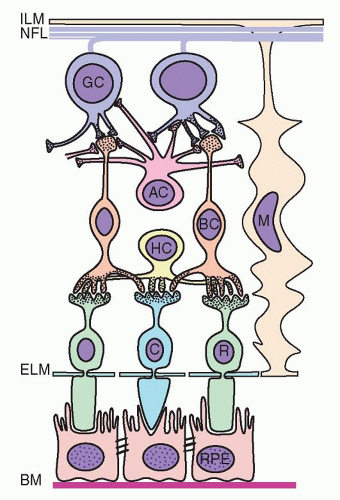Normal Anatomy of the Macula
J. Fernando Arévalo
Carlos F. Fernández
INTRODUCTION
Francisco Buzzi in Milan, Italy, was the first to anatomically define the macula at the end of the 18th century (1782-1784). He described it as the yellow portion of the posterior retina, lateral to the optic nerve, with a depression in its center. Also in the 18th century (1797), Fragonard, a French ophthalmologist, made a very detailed description of the foveal zone, but he failed to mention the central foveola. In addition, Soemmering (1795-1798) described the macula lutea; however, he thought that the foveola was a hole or foramen (foraminulum centrale retinae) and correlated it to the blind spot of the visual field. Finally, Michaelis in 1838 established the role of the macula, and it was confirmed by Müller in 1856. At the end of the 19th century, Tratuferi in Italy showed the first schematic drawings with the topographic localization of the retinal layers. The relationship between the retinal axonal layer, cones, and rods was established by Ramon y Cajal in 1894 (1).
The macula is recognized as the specialized region of the retina in charge of high-resolution visual acuity. Anatomically, it can be defined as the central part of the posterior retina that contains xanthophyll pigment and two or more layers of ganglion cells. In this chapter, we focus primarily on the aspects of the normal anatomy of the macula as an introduction to the understanding and management of age-related macular degeneration.
EMBRYOLOGY
The neural components of the eye are an extension of the forebrain, and thus part of the central nervous system (Table 1.1).
The Neuroretina
The embryogenesis of the neuroretina occurs during the first month of life. The forebrain consists of a single layer of neuroectodermal cells. The optic vesicle extends laterally from the forebrain and then invaginates to form the optic cup. There is a double layer of neuroectodermal cells in the optic cup; the apices are together and basal aspects apart. The macular area appears at the end of the 4th week.
The inner layer of neuroectoderm becomes the sensory retina posteriorly. Part of the inner limiting membrane is the basement membrane of the sensory retina, next to the vitreous. The foveal pit forms late in embryonic life, and morphologic maturity does not occur until the age when it is possible to obtain 20/20 visual acuity in small children (2). The induction of the foveal pit requires a normal pigment epithelium (3). The inner layer of neuroectoderm is divided into the inner neuroblastic layer (Müller, amacrine, and ganglion cells) and the outer neuroblastic layer (cone and rod, horizontal, and bipolar cells). Between the inner neuroblastic layer and the outer neuroblastic layer is the transient fiber layer of Chievitz; this layer will progressively disappear.
Table 1.1 DEVELOPMENT OF THE SENSORY RETINAa | ||||||||||||||||||||||||||||||||||||||||||
|---|---|---|---|---|---|---|---|---|---|---|---|---|---|---|---|---|---|---|---|---|---|---|---|---|---|---|---|---|---|---|---|---|---|---|---|---|---|---|---|---|---|---|
| ||||||||||||||||||||||||||||||||||||||||||
The central and peripheral retinae start to differentiate between the first and third months. The ganglion cell layer becomes thicker, as do the inner plexiform layer and the amacrine cell layer. The cones appear in the 5th month. They are a protoplasmic extension of the outer neuroblastic layer (4,5,6). The rods appear in the 6th month (5). The macula becomes thinner in the 7th month because the cells of the different layers move laterally, and the foveal pit appears more evident (Fig. 1.1) (7,8).
The Retinal Pigment Epithelium
The outer layer of neuroectoderm (toward the sclera) becomes the retinal pigment epithelium (RPE), the pigmented ciliary epithelium, and the iris dilator muscle. The basement membrane of the RPE forms the innermost part of the Bruch’s membrane (9).
Pigmentation of the neuroectodermal cells occurs early and is completed during embryonic life (10), whereas pigmentation of the uveal stroma, which is derived from the neural crest, starts much later and is not complete until several weeks after birth (9). The melanin granules of the neuroectoderm are larger and chemically different from those of the uveal stroma (11). Moreover, melanin content of the RPE is similar in all persons, regardless of race, in contrast to the amount of uveal stromal pigmentation, which corresponds to the racial pigmentation of the skin and hair (10).
Vascularization
Vascularization of the retina begins during the 16th week of gestation at the optic nerve head (12) and normally reaches the ora serrata nasally by term. It is not quite complete temporally at term because the distance from the optic nerve head to the ora is greater.
There are differing theories as to how vascularization of the macula occurs. Some have proposed that the capillary-free zone (CFZ) develops by regression of previously formed capillaries, because the retina is thin enough in this area that sufficient oxygen can diffuse inward from the choroidal circulation (12). Others believe that the CFZ forms primarily, with the embryonic vessels gradually encircling the center of the fovea and with no evidence of regression (13).
The Choroid
In the first phase, at 4 weeks, the choroid begins to take form in the undifferentiated mesenchyma surrounding the optic cup. At 5 to 6 weeks, endothelial tubes near the pigment epithelium differentiate into capillaries. Simultaneously, the Bruch’s membrane and the vortex veins appear. With the appearance of the posterior ciliary arteries at 8 weeks, the choriocapillaris is fully established as a discrete layer.
During the growth phase in the 3rd month, the anterior capillaries arrange themselves in a linear and radial pattern. The anterior supply of the choriocapillaris is complete by 3 months, even though the ciliary body and iris are not yet formed. The capillaries drain into the supra- and infraorbital venous plexi.
The second phase of choroidal growth includes the formation of large vessels (Haller’s layer) at 4 months. The third phase begins around the 5th month and is characterized by the formation of medium-sized vessels posterior to the equator. Anterior to the equator, there are only two layers of vessels, the choriocapillaris and medium-sized vessels.
Pigmentation of the choroidal melanocytes commences in the 5th month and continues until after birth, beginning outward near the sclera and progressing inward toward the Bruch’s membrane. The peripapillary, intrascleral vascular circle of Haller and Zinn develops between 3 and 6 months. Between the 6th and 10th month, the major arterial circle of the iris forms recurrent arterial branches that supply the anterior choroid during its rapid growth phase (14).
TOPOGRAPHIC ANATOMY
The terms macula and fovea are used in different ways by the anatomist and the clinician. Anatomically, the macula (macula lutea or central retina) is defined as the portion of
the posterior retina that contains xanthophyll and two or more layers of ganglion cells. This region is about 5.5 mm in diameter and is centered approximately 4 mm temporal and 0.8 mm inferior to the center of the optic disk (15). It corresponds clinically to the posterior pole and is approximately bounded by the superior and inferior temporal vascular arcades. On the basis of microscopic anatomy, the macular area can be further subdivided into several zones (Fig. 1.2).
the posterior retina that contains xanthophyll and two or more layers of ganglion cells. This region is about 5.5 mm in diameter and is centered approximately 4 mm temporal and 0.8 mm inferior to the center of the optic disk (15). It corresponds clinically to the posterior pole and is approximately bounded by the superior and inferior temporal vascular arcades. On the basis of microscopic anatomy, the macular area can be further subdivided into several zones (Fig. 1.2).
What is clinically referred to as the macula corresponds to the anatomic fovea. The fovea (fovea centralis) is a depression in the inner retinal surface in the center of the macula. It measures approximately 1.5 mm, or one disk diameter in size, and it is more heavily pigmented than the surrounding retinal tissue. The central floor of the fovea is called the foveola. The anatomic foveola, often referred to clinically as the fovea, measures approximately 0.35 mm in diameter. It lies within the CFZ, which measures approximately 0.5 mm in diameter in most patients. A small depression in the center of the foveola is called the umbo, where the retina is only 0.13 mm thick. A 0.5-mm-wide ring zone where the ganglion cell layer, inner nuclear layer, and outer plexiform layer of Henle are the thickest is called the parafoveal area. This zone is in turn surrounded by a 1.5-mm zone referred to as the perifoveal area (16).
CLINICAL APPEARANCE
The anatomic subdivisions of the macula are ill-defined ophthalmoscopically. The margins of either the 0.35-mm diameter foveola or the 1.5-mm diameter fovea are difficult to define. A poorly defined zone of greater pigmentation (one-fourth to one disk diameter in size) corresponds to the center of the macula, which is maximum in the foveolar area. The foveal reflex is present in most normal eyes, and it lies just in front of the center of the foveola (Fig. 1.3). We can see the foveal depression with the narrow slit lamp beam.
The central retinal artery supplies the inner half of the retina. It usually divides into a superior and inferior trunk within the optic nerve head. These trunks divide into a nasal branch and a temporal branch. The corresponding retinal venous branches have much the same distribution as the
arteries. They give off arteriolar and venular branches that posteriorly occur primarily at right angles to the parent vessel. They divide in a dichotomous way as they course peripherally. The right-angle branches are referred to as first-order arterioles and venules. One or more cilioretinal arteries derived from the ciliary circulation supply the papillomacular area in approximately 20% of patients (17), and occasionally the entire macula (Fig. 1.4). The blood vessel walls are normally transparent (16,18).
arteries. They give off arteriolar and venular branches that posteriorly occur primarily at right angles to the parent vessel. They divide in a dichotomous way as they course peripherally. The right-angle branches are referred to as first-order arterioles and venules. One or more cilioretinal arteries derived from the ciliary circulation supply the papillomacular area in approximately 20% of patients (17), and occasionally the entire macula (Fig. 1.4). The blood vessel walls are normally transparent (16,18).
GROSS ANATOMY
The retina loses its normal transparency within hours after death. Xanthophyll is a yellow pigment made up of two carotenoids (zeaxanthin and lutein) (19,20). It is apparent in the center of the macula and is highly concentrated in the foveolar area. The maximal concentration of xanthophyll pigment is in the outer nuclear and outer plexiform layers. However, we can find xanthophyll within the inner plexiform layer inside the foveal area (19,21,22,23). The greatest concentration of pigment is in the cones’ central axons (23).
The entrance site for the short and long posterior ciliary arteries can be visualized after removal of the choroid. There is no retinal circulation at the foveola. The short posterior ciliary arteries are concentrated in the macular area along the temporal margin of the fovea and the peripapillary area. The temporal long posterior ciliary artery and ciliary nerve enter about one and one-half disk diameters temporal to the center of the fovea (16).
HISTOLOGY
In the macula, we find the thickest portion of the retina surrounding the thinnest portion, the foveolar area. At the umbo, the neural retina consists only of the inner limiting membrane, the Henle’s fiber layer, the outer nuclear layer, the external limiting membrane, and the photoreceptors’ outer and inner segments (Fig. 1.5). The typical neural-retinal histology is established out of the foveola (Fig. 1.6). The neural retina consists of the inner limiting membrane, the nerve fiber layer (NFL), the ganglion cell layer, the inner plexiform layer (synaptic processes between bipolar
cells and ganglion cells), the inner nuclear layer (nuclei of bipolar, horizontal, amacrine, and Müller cells), the outer plexiform layer (synaptic processes between bipolar cells and photoreceptors), the outer nuclear layer (nuclei of the rods and cones), the external limiting membrane (formed by cell junctions between photoreceptors and the terminal optical processes of Müller cells), and the photoreceptor layer (rod and cone cells). The bipolar cells, ganglion cells, fibers of the outer plexiform layer (Henle’s fiber layer), and Müller cells are displaced circumferentially and show an oblique orientation in the macula that causes thickening of the marginal zone and a central thinning of the retina, forming the fovea.
cells and ganglion cells), the inner nuclear layer (nuclei of bipolar, horizontal, amacrine, and Müller cells), the outer plexiform layer (synaptic processes between bipolar cells and photoreceptors), the outer nuclear layer (nuclei of the rods and cones), the external limiting membrane (formed by cell junctions between photoreceptors and the terminal optical processes of Müller cells), and the photoreceptor layer (rod and cone cells). The bipolar cells, ganglion cells, fibers of the outer plexiform layer (Henle’s fiber layer), and Müller cells are displaced circumferentially and show an oblique orientation in the macula that causes thickening of the marginal zone and a central thinning of the retina, forming the fovea.
 Figure 1.4 ▪ FA shows a cilioretinal artery. (Courtesy of Dario Fuenmayor-Rivera and Enrique Murcia.) |
 Figure 1.5 ▪ Histology of the normal macula. CFZ, capillary-free zone; f, foveola; u, umbo. (Microphotograph courtesy of Dario Savino-Zari.) |
Müller cells are modified glial cells. They span the region from the internal limiting membrane to the external limiting membrane, and they give support to the neural elements of the retina. The internal limiting membrane consists of a basement membrane, which is a surface modification of the vitreous body, and the expanded vitreal processes of Müller cells. This membrane is relatively thick in the macular region except in the area of the foveola. The internal limiting membrane serves as
an anchoring structure for the collagen framework of the vitreous. The outer limiting membrane is formed by junctional complexes between cell membranes of the Müller cells and inner segments of photoreceptors. Müller cells are connected to the visual cells by a system of terminal bars (24,25). These junctional complexes probably provide at least a partial barrier to the passage of large molecules in either direction.
an anchoring structure for the collagen framework of the vitreous. The outer limiting membrane is formed by junctional complexes between cell membranes of the Müller cells and inner segments of photoreceptors. Müller cells are connected to the visual cells by a system of terminal bars (24,25). These junctional complexes probably provide at least a partial barrier to the passage of large molecules in either direction.
The retinal blood vessels supply the inner half of the retina. The major branches of the retinal arterial system have the structure of small arteries, persisting even beyond the equator (15). Retinal arteries do not have an internal elastic lamina; however, they have a well-developed muscularis (five to seven layers of smooth muscle cells posteriorly; one or two layers peripherally). Near the optic disk, the retinal veins have three to four layers of smooth muscle cells, and after a short distance, the muscle cells are replaced by fibroblasts. There is controversy concerning the pattern of distribution of the capillary network in the retina (diffuse arrangement or a two- or three-tier arrangement) (15,26,27




Stay updated, free articles. Join our Telegram channel

Full access? Get Clinical Tree






